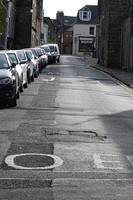Fish Gait
Fish Gait
The road leading from North Street to the Castle used to be called Fish Gait. The early history of the road is unclear. It has been suggested that Fish Gait is one of the oldest streets in St Andrews. However, archaeological excavations in the 1980s found that there was limited development in this area before the fourteenth century. By the early fifteenth century Fish Gait was a well-established street, and the land on each side had been divided into small plots. The name Fish Gait may indicate the line of work pursued by some of the street's residents. In the late Middle Ages St Andrews' fish market was located towards the east end of North Street, quite near to the junction with Fish Gait.
Street View
Additional Information
Location: North Castle Street. Date Built: Uncertain - road in existence by late fourteenth century.
The term "gait" is a Scottish word for street. In the Middle Ages the main streets in St Andrews were often referred to as gaits. For example, North Street was normally called "North Gait".
At one stage St Andrews Cathedral owned property on Fish Gait. In 1427 the Cathedral canons granted a plot of land on Fish Gait to a man named John of Culross in exchange for a yearly rent of 2 shillings.
The 1546-47 siege of St Andrews Castle must have affected life in Fish Gait. A siege mine dug by the castle's attackers started at the end of the street, and it is possible that houses on Fish Gait were hit by misdirected cannon balls during the bombardment of the castle in July 1547.
The current buildings on Fish Gait are post-medieval. All Saints Church (on the west side of the street) was founded in 1903.
